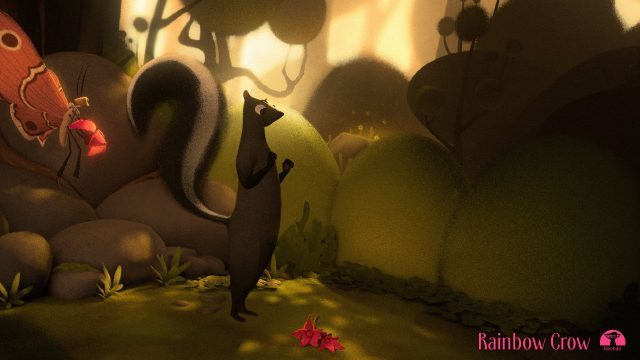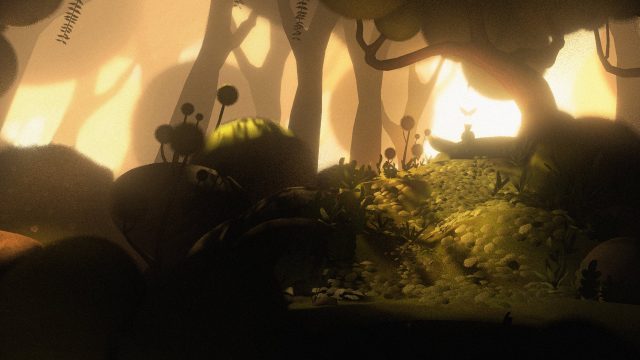By now it’s trite to call any CG VR film studio “the Pixar of VR,” but one reason for that pervasive comparison is that Pixar’s waxy-textured, brightly-colored, hard-edged geometry has become a dominant style for big-budget CG films. But we hear over and over about how ‘VR is a completely new medium’; doesn’t it deserve a new look? Baobab Studios‘ latest work, Rainbow Crow, is starting to branch out from that style with a unique new look that taps into VR’s strengths.
Executive-produced by and starring the voice of John Legend, Rainbow Crow is Baobab’s latest CG VR film project following shorts INVASION! and ASTEROIDS!. The piece is an interpretation of a Native American folktale about how the modern day crow came to be. The video you’ll see below introduces the tale, but all the visuals are concept art.
Baobab has exclusively given Road to VR the first captures from the actual rendering within the experience itself, showing their new visual style which uses what they’re calling a soft “dithering” approach combined with strongly stylized lighting. Although they say it’s still a work in progress, you can see that it’s quite beautiful and different than their prior work, and many the Pixar-esque CG VR film pieces we’ve seen elsewhere.


This dithering effect, which you can see predominantly in the tail of Becky the skunk, actually works uniquely well in VR because it makes objects like the tail semi-transparent which reads especially well thanks to 3D; it shows the volume of the object in a more tangible way than a solid object. It also ‘leaks’ light and color from objects behind, melding disparate elements of the scene into what the studio is calling a dreamy “storybook” look.
Baobab says that the effect came about through a back and forth between the company’s art and tech teams. The concept artist mocked up a look which explored some fuzzy edges for softer objects like foliage and fur.
This style was well received, and the tech team set about seeing if they could devise a method for efficiently achieving the look in real-time. Once that was proven out, the technique was taught to the digital artists to begin employing it throughout Rainbow Crow’s development.
Accompanying the dithering effect is Rainbow Crow’s stylized lighting, which you can see has also been impressively replicated from the vision laid down in the concept art. Whereas the Pixar style often takes a realistic approach to lighting, Rainbow Crow’s warm, over-exposed lighting enlivens the scene with emotion. Again, this ’emotional lighting’ approach feels uniquely suited to VR because it colors (literally and figuratively) the entire scene around you, no matter where you look. It suggests a feeling that realistic-lighting would not, and purposefully sets the stage as warm and glowy for a narrative which hinges on the prospect of an eventual cold and eternal Winter.
Both the dither and the emotional lightning play to the stage-like setup that Baobab has constructed to tell the story of Rainbow Crow. As Road to VR’s Paul McAdory recently put it in his preview of the piece at TriBeca:
The experience begins and ends on a patch of grass in the woods. Rainbow Crow’s forest circumscribes the viewer. The first chapter of a project that will ultimately encompass at least three situates you in the center of a small clearing, a sort of audience dais, and treats the enclosing flora as a stage, kliegs included.
As the viewer you are encompassed by the dense forest, with only indirect light bouncing under the canopy from the periphery. You’re situated down low compared to some nearby mounds and built-up foliage on every side. Lighting against each of the surrounding faces of geometry helps guide your eye as the action moves, and the mounds offer a way for the characters to work the stage vertically rather than just horizontally.
At least in the few short minutes of Rainbow Crow’s first chapter, the visuals and stage-like set haven proven to be both a unique visual treat and an effective communication of emotion and direction. I’m looking forward to seeing how these approaches are applied in future chapters of Rainbow Crow, especially as the story takes the viewer out into space to follow the character’s journey to find out what’s causing the eternal Winter.
VR is a whole new medium. I’m hopeful that Baobab’s exploration of new visual styles in VR film will encourage others in the space to do the same. Maybe then we can stop the oversimplified comparisons to Pixar, and instead focus on what CG VR film does differently, not what it does the same.


